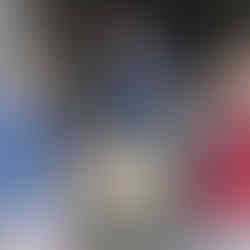Heading Into Spring
- Phoebe Moulthrop
- Apr 2, 2023
- 4 min read
"Wait! Did that just move?!" A group of kids were simultaneously trying to get as close as possible while keeping their bodies calm and not disturbing the eggs. As we looked at each egg illuminated by a bright light, we could see the shape of the developing embryos and watch them float from one side of the shell to the other. Kids noticed veins and darker and lighter patches. A number of them commented on how the eggs felt heavier to them than ones they have used for cooking. All week they have been reminding each other to jump gently, to not run, and to be careful around the eggs. I am grateful that they have this chance to watch this process.
Morgan's PK and K Class
* Worked with spring stencils and markers. They were excited to learn they could trace the outside of the stencils as well and reuse them for their play dough creations.
* Worked with each other to create paintings on different sized paper.
* Explored shaving cream with food coloring. The children were excited to make predictions and observe what happened as they mixed them together.
* Read spring and chicken books!
* Took turns at guessing the different nature items in the magnifying glass blocks. Some of the items were easy to identify while others were a little harder. The children also enjoyed finding small objects to put in the blocks as well.
* Built with Legos and blocks of various sizes.
* Learned about the letter of the week - V. Practiced making upper and lower case Vv.
* Looked for signs of spring outside by finding bugs and worms, played in the stream, popped bubbles, and climbed trees!
* Participated in the last mini class for the month of March.
* Looked at the chicken eggs in a dark room with the little light on top of the incubator to see which of the eggs are fertilized! This is called "candling". Many of the children were excited to see dark shadows or the veins in the chicken eggs.
Tracy's 1st-3rd Grade Class
In math, we have been noticing that are lots of different ways to get to the correct answer. Our first grade class has been working on knowing ten more and ten less of a given number. They can do this by using a number grid, by modeling it (or notating it) with base ten blocks. or by looking at the tens place and simply changing it one more or one less. I love it when kids make a case for why their way is more efficient. The second graders are working on developing comfort with two and three digit subtraction. The third graders are learning about order of operations and parentheses. They were intrigued to find that the same set of numbers and mathematical symbols could give two different answers depending on what part of the problem is done first.
In writing, we are working on figuring out the differences between opinions and facts. Like Theresa's class, we used a "Smash Boom Best" episode on Pancakes vs. Waffles to help us learn about some debate techniques. Each child is developing arguments for a debate, and we are looking for supporting facts.
In reading, we have really been working on using context and meaning clues to help us figure out the meaning of unknown words. We also continue to focus on a few useful word patterns each time we read. When I am checking for understanding, we often use made up words to make sure that the rules are being applied correctly (ex: zame or grupping).
Theresa's 4th-6th Grade Class
It was a mellow week at Country Classroom. Between the storms and the sunshine, we managed to do some learning.
In math, the eldest kids are working on surface area and volume of different shapes. It has been a refreshingly easy unit, after one that was more challenging. The 4th and 5th graders are continuing to work on decimals, fractions and percents.
In writing, we are doing a study of debate. The kids are listening to debates on the podcast "Smash Boom Best." We are talking about how strong arguments need reasons and examples. The podcast uses a lot of gimmicks to keep the listener's attention. Those gimmicks have their place, but they cannot be the argument. We have been looking for the topic sentences and supporting reasons in each of the arguments.
We are reading from the American History Book, "A History of US." We are reading about the Civil War, which Tracy is also studying in the afternoons. We are talking about strategies for reading non-fiction, such as summarizing and paraphrasing. We are also talking about the difference between primary and secondary sources. The book is full of images of primary sources, and they have inspired many of our conversations. One of the most wonderful things about teaching your kids is how utterly appalled they are by the injustices of the world. They have a strong sence of riht and wrong, and they are able to discuss it.










































Comments